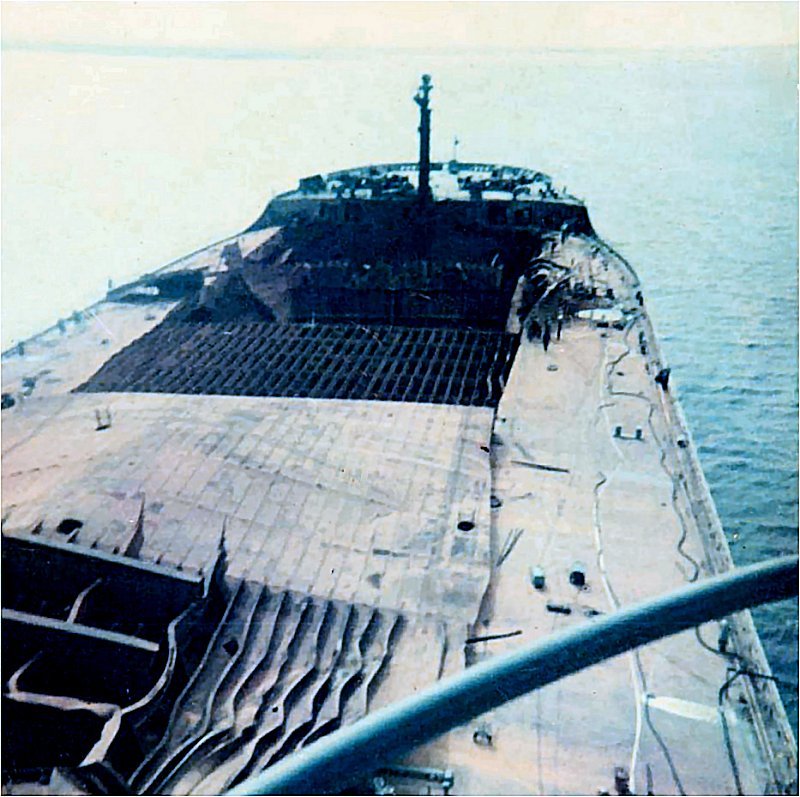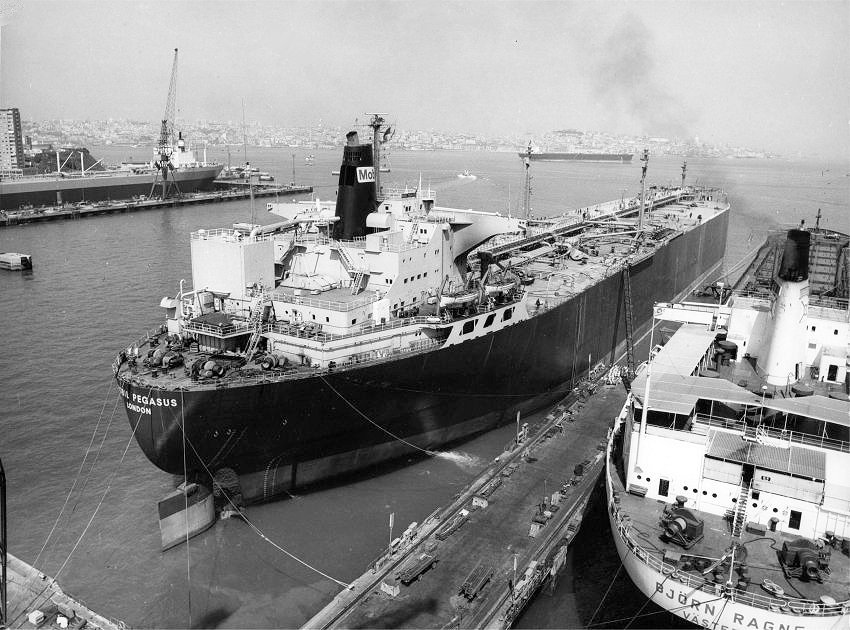Auke Visser's MOBIL Tankers & Tugs Site | home
Catastrophic Explosion on the Mobil Pegagus"
Norman Doodson, wrote to me the following :
Dear Mr Visser.
My son recently found 2 photos I took after the explosion on the "Mobil Pegasus"
He urged me to write a short biography of the accident for my grandchildren, which I attach for your interest.
Catastrophic Explosion on the Mobil Pegagus
My name is Norman Doodson and I joined the "Mobil Pegasus" as second officer offshore Las Palmas on 9th April 1973 with my wife who, happily as it turned out, was a trained nurse.
We proceeded to Bonny in Nigeria to load a full cargo of crude oil for discharge in Europe. Whilst loading this cargo there was a lightning storm which struck, and set alight, the gas vent on the foremast. Happily this was quickly extinguished.
From there we proceeded to part discharge at Le Havre and then on to Coryton, in the Thames estuary. Thence, we were bound in ballast for the Persian Gulf.
The Master was Capt. Perry . There was a Chief Officer, also accompanied by his wife, another second officer and a third officer. The second and third officers kept watches whilst the Chief Officer worked days which on the ballast voyage was predominantly the tank cleaning operation to ensure that the vessel arrived in the load port with clean ballast which could be discharged overside.
On 22nd June (the date I left the ship "at sea" according to my discharge book)we were in the South Atlantic and I had been on watch from midnight to 4am and recall noting in the Deck Log Book that the sea state was "slight". However, as I was to find out later that day what appeared slight from the bridge deck of a supertanker was far from it at water level in an open boat.
At 0755 I was abruptly awoken by what I recall as a double bang followed very quickly by the general Alarm and shortly afterwards by the smell of burning coming through the air-conditioning system. My wife and I quickly dressed, picked up our lifejackets and proceeded to the bridge. En-route I met the Chief Officer and, whilst my wife went up to the bridge, he and I proceeded on deck.
The scene that greeted up was every seafarer’s nightmare. The force of what we found out had been a tank explosion, rather than the collision I had imagined ,had folded the cargo deck back from the foc's'le deck to part way back over tank 2 and a part of the deck of tank 1 was hanging over the port side ..The second bang I assumed was the piece of flying debris that left No.2 lifeboat hanging by one davit .Given that the ship had only 5 tanks longitudinally (with port and starboard wing tanks) this was an enormous hole from which flames were leaping around 100 feet into the air and producing a very tall smoke plume reminiscent of a small nuclear explosion!
The tank cleaning gang had clearly been working on the port side of the cargo deck and the first thing I noticed, other than the desolation, was the other Second Officer donning the flame retardant suit to rescue an injured crewman from the explosion site . An act of the utmost bravery. I recall there being three injured crewmen, one of whom had a severe scalp laceration and other medical issues including extensive burns.
AS a result of the explosion the fire service line on deck was ruptured and we had to run fire hoses from far back behind the deckhouse. Imagine the consternation when we found that the new hoses in the fire equipment store would not couple together and we had to gather hoses from the deck fire hose boxes to join up to make a hose long enough to stretch from the undamaged section of the fire line to a point where we could spay water into tank 1. The flames were intense and it was difficult, not to say dangerous, to approach too close to the edge of the tank.
At some point in the morning, the fire still blazing, I became concerned that the tank upon which we were standing was getting very hot and was a potential explosion hazard. I called the bridge from the pump room telephone and perhaps it was this that influenced the Captain as shortly afterwards he told us to pull back and prepare to abandon ship.
The vessel had 4 lifeboats 1 & 3 on the starboard side and 2 & 4 on the port side. Numbers 1 and 2 boats were motor powered but No.2 had been put out of action as a result of the explosion. The Captain advised that the 3rd. Officer and I (and my wife) would take boat No.3 with the injured crewmen, the bulk of the catering staff and a couple of deck hands as he was reserving the other lifeboat for the balance of the ships company.
We collected the injured from the ships rudimentary hospital where my wife had been doing an excellent job of looking after the injured crewmen and, after lowering the boat to the embarkation deck we carefully loaded the injured onto the lifeboat. We had to lay the injured on the side benches in the boat, making it rather cramped for the others.
The boat was lowered to the water, the falls and painter slipped and the boat drifted astern, passing under the counter until we came close to the propeller which was partly exposed above the water. At this time, the main engine stared up and the propeller was turning with the imminent risk that the boat would be severely damaged and the crew injured or killed - not a good result given how the day was going thus far. I called to the bridge on the walkie talkie to stop the propeller as we were getting perilously close, bow first, where the third officer was standing, to the turning blades. The crew were "losing the place" and it was difficult for the two officers to maintain some sort of order and discipline.
With the propeller stopped we drifted clear of the ship and I ordered the crew to prepare to row the boat - not an easy task as what had been slight seas when I completed the deck log at 4am turned to be a significant swell - and the fact that the crew had no training in rowing and my own training was a day or so rowing a whaler round St. Katherine’s Dock during my apprenticeship training. However, when needs must the devil drives and we successfully managed to row a short distance to clear away from the ship where we streamed the sea anchor to hold our bows into the seas.
What had seemed empty ocean those few hours earlier it was now clear that there was a circle of ship standing-by to render assistance which was very reassuring. After an hour or so in the lifeboat we were recovered from the boat by a ship from the Polish Ocean Line.
The Polish officers were extremely kind to us providing us with new clothes (we had left the ship with the clothes we stood up in) and we were welcomed by the Captain who celebrated our arrival with vodka (what else!) More importantly the ship carried a doctor who tended to our injured crew, one of whom had a severe scalp laceration and other medical issues including extensive burns. I recall that the most injured crewman was resuscitated three times.
The Polish ship proceeded to Luanda in Angola from where we flew to Lisbon and on to London.
I flew back to re-join the ship in Dakar from where, escorted by the ocean going tug "Zee Falke", we proceeded to the Lisnave shipyard in Lisbon, which at that time was one of the few dry docks in Northern Europe that could accommodate a ship of that size. I flew home from Lisbon.
the catastrophic explosions of three other vessels, the “Kong Haakon V11 ,and the Shell tankers Mactra and Marpessa all of which vessels were cleaning tanks at the time of the explosions and in more or less the same warm water latitude . One theory is that the equivalent of a thunder storm formed in the huge tank and that a statically charged water droplet passed through the thunder cloud, thereby causing a spark. There was, as I recall at the time some discussion as to whether the vortex breaker in way of the tank suction which came up from the double bottom could have had an effect – who knows? - but in Stephen Howarth’s excellent book
“A Century in Oil” he states “: Two years of intense experiment and investrigation established both the cause and the cure. It became apparent that each explosion had taken place during tank cleaning operations. The cleansing water spray had created an electrically charged mist which, inside the vast spaces of the VLCC hold, could form a a cloud large enough to generate sparks – a miniature thunder storm, fatal to the tanks gaseous atmosphere. The cure was to flood the tank with inert gas.”
 Photo of main deck.
( Photo Norman Doodson )
 Photo of the repaired "Mobil Pegasus" at Lisnave shipyard, Lisbon.
( Photo Bruno Huriet )
|